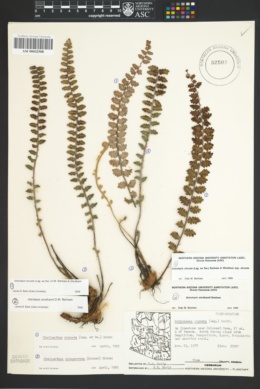|
|
|
|
Family: Pteridaceae
Mexican scaly cloakfern, more...Mexican scaly cloakfern, wavy scaly cloakfern
[Astrolepis sinuata subsp. mexicana D.M. Benham, moreCheilanthes sinuata (Lag. ex Sw.) Domin] |
Stems compact to short-creeping; stem scales uniformly chestnut brown or with lighter margin, to 6 mm, margins ciliate-dentate. Leaves 11--130 cm. Blade pinnate-pinnatifid, pinna pairs 30--60. Pinnae deltate to ovate, largest 7--35 mm, symmetrically lobed, lobes 6--14 often acute, separated by deep sinuses; abaxial scales concealing surface, lanceolate, usually 1--1.5 mm, ciliate-dentate with delicate marginal projections; adaxial scales sparse, deciduous, elongate, stellate, attached at base, body 1--2 cells wide, attached at base. Sporangia containing 32 or 64 spores. Astrolepis sinuata comprises two cytotypes that tend to occupy different ranges and are treated here as subspecies. Sexual diploid populations (subsp. mexicana ) are widely distributed in Mexico, but in the flora they are apparently confined to the Davis and Chisos mountains of Texas and to southeast New Mexico. The range of the apogamous triploid (subsp. sinuata ) extends from Argentina to the southwestern United States, with a disjunct population in Georgia. Isozyme studies suggest that subsp. sinuata was derived from the diploid subsp. mexicana through autopolyploidy (D. M. Benham 1989).
Sporangia containing 64 spores; spores averaging 37--44 µm diam. 2 n = 58. Sporulating summer--fall. Rocky slopes and cliffs; occurring on calcareous and noncalcareous substrates; 1300--1800 m; N.Mex., Tex.; Mexico; Central America. General: Compact stems to short creeping, 11-130 cm high, stem scales uniformly chestnut brown or with lighter margin, to 6 mm, margins ciliate-dentate. Leaves: Blade pinnate-pinnatifid, pinna pairs 30-60, pinnae deltate to ovate, largest 7-35 mm, symmetrically lobed, lobes 6-14 often acute, separated by deep sinuses; lower scales concealing surface, lanceolate, usually 1-1.5 mm, ciliate-dentate with delicate marginal projections; upper surfaces sparse, deciduous, elongate, stellate, attached at base. Sporangia: Usually contains 32, sori and sporangia mostly or completely hidden by scales, sori rounded or oblong and borne submarginally at tips of veins, indusia wanting. Ecology: Found on dry rocky hillsides and along canyon walls and in crevices from 2,500-7,000 ft (762-2134 m); sporulating summer into fall. Notes: Distinguished by its fuzzy, oval, wavy–edged leaflets, which are super sinuous. This species occurs on both calcareous and noncalcareous substrates. Two subspecies in the region: ssp. sinuata and ssp. mexicana. The two are morphologically similar according to Bentham 1992, with the only distinctions spore number and size and chromosome numbers. The latter species is limited in distribution to the Chisos and Davis mountains in west Texas and in southeast New Mexico Etymology: Astrolepis is from the Greek astron, a star, and lepis, scale, which refers to the scales on the blade surface, while sinuata means having sinuous or wavy margins. Sources: FNA 1993, Wiggins 1964, Kearney and Peebles 1969, Bentham 1992, Yarborough and Powell 2002 FNA 1993, Wiggins 1964, Kearney and Peebles 1969, Bentham 1992, Yarborough and Powell 2002 Common Name: wavy scaly cloakfern General: Compact stems to short creeping, 11-130 cm high, stem scales uniformly chestnut brown or with lighter margin, to 6 mm, margins ciliate-dentate. Leaves: Blade pinnate-pinnatifid, pinna pairs 30-60, pinnae deltate to ovate, largest 7-35 mm, symmetrically lobed, lobes 6-14 often acute, separated by deep sinuses; lower scales concealing surface, lanceolate, usually 1-1.5 mm, ciliate-dentate with delicate marginal projections; upper surfaces sparse, deciduous, elongate, stellate, attached at base. Sporangia: Usually contains 32, sori and sporangia mostly or completely hidden by scales, sori rounded or oblong and borne submarginally at tips of veins, indusia wanting. Ecology: Found on dry rocky hillsides and along canyon walls and in crevices from 2,500-7,000 ft (762-2134 m); sporulating summer into fall. Notes: Distinguishing characters for the genus are once-pinnate leaves with lobed pinnae, dense scales covering pinnae under-surfaces and dense to sparse stellate scales on the upper surfaces. This species is one of the two larger, more robust Astrolepis species (the other is A. windhamii) and is distinguished by the larger, symmetrically-lobed pinnae (7-35 mm) sparse scales on upper-surfaces, the scales 1-2 cells wide and appearing more elongate than the similar windhamii. It occurs on both calcareous and noncalcareous substrates. Two subspecies in the region: ssp. sinuata and ssp. mexicana. The two are morphologically similar according to Bentham 1992, with the only distinctions spore number and size and chromosome numbers. The latter species is limited in distribution to the Chisos and Davis mountains in west Texas and in southeast New Mexico Ethnobotany: Unknown Etymology: Astrolepis is from the Greek astron, a star, and lepis, scale, which refers to the scales on the blade surface, while sinuata means having sinuous or wavy margins. Synonyms: None Editor: SBuckley 2010, FSCoburn 2015 |
|
|
|











